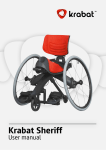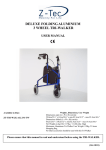Download User Manual
Transcript
safety precautions Before use follow the precautions below: ! Ensure all the legs on the walker are set to equal heights and that this is the correct height for the user ! Ensure the brass push buttons have securely locked the legs in position ! Do not exceed the weight limit of 160kg (25 stone) ! Ensure the ferrules have sufficient grip and beware of slippery surfaces such as wet floors, wet leaves, etc. ! Inspect the walker regularly for signs of damage or wear (see care and maintenance section). ! Check ferrules regularly - replace if worn and uneven. Note: Some models come with front wheels. For these models the rear legs should be set 1 hole higher than the front legs to compensate for the extra height of the wheels. Seek advice from a physiotherapist or Occupational Therapist on adjusting the walker to the correct height. 3. For wheeled walkers push the walker a short distance ahead then step forward with the worst affected leg leading. Glide caps: The wheeled walkers come with optional glide caps to help users walk on surfaces such as carpet. These should only be used on suitable indoor surfaces. using the walker Note: All recommendations contained herein should be checked with your health professional (such as occupational therapist or physiotherapist) before use ! If using with a chair, ensure the chair has arms and a high seat to help you stand up and sit down easily. To install the glide caps push the cap on to the bottom of the rear ferrules (as shown). Pull down on the glide caps to remove. We recommend that you consult you healthcare professional before using the glide caps. ! height adjustment Ensure there are no obstacles on the surface such as rugs, loose flooring or wet leaves. using the walker with chairs ! Avoid wet floors and uneven surfaces. ! Take care when storing or carrying the walker to avoid damage. In the event of an accident the walker should be inspected before use. ! The walker should be cleaned regularly with a damp cloth and mild disinfectant. Bleach or solvents should not be used. The height of the walker should be adjusted to suit each user for safety and comfort. General Safety When Using: To adjust the leg height: 1. Push in the brass buttons (as shown in the diagram). 2. Extend or retract the leg to the raise or lower the height. 3. When the required height is reached, release the button and ensure the leg locks in to position. 4. Repeat for the other legs, ensuring all legs are securely locked in position and all adjusted to the same height. To sit down: 1. Turn around in front of the chair so you have your back to the chair. Ensure that you can feel the chair behind you on the back of your legs. 2. Place one hand back onto the arm of the chair then the second hand. Bend slightly forward and lower yourself gently onto the seat. Walking: 1. Place the walker one step ahead and place all four legs on the floor. 2. Step forward with the worst affected leg first, then bring the second leg forward level or just past the first. Do not step too far in to the frame. To stand up from a chair: 1. Put the walker in front of the chair. 2. Stand up from the chair using your arms on the chair arms if necessary. When stood up, move your hands to the walker handgrips before beginning to walk.







